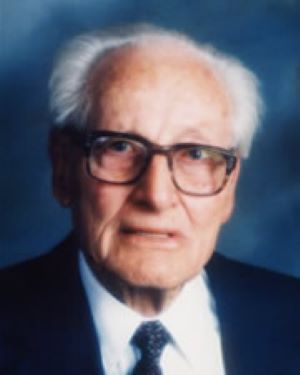

Edward F. Knipling and Dr. Raymond Bushland
UNITED STATES
The 1992 World Food Prize recognized a team of entomologists who gave the world an environmentally friendly means of controlling insects that threaten the production of crops and livestock. With global population growing by over 95 million people a year, effective control of pests is crucial to preserving the world food supply.
Full Biography
Recipients' Background
Dr. Raymond C. Bushland and Dr. Edward F. Knipling of the United States were honored for their contribution to sustaining vast sources of food, especially livestock and wildlife populations, and consequently ensuring human health. Drs. Bushland and Knipling developed the Sterile Insect Technique (SIT), which was first used to eliminate screwworms, insects that prey on warm-blooded animals, especially cattle herds. With larvae that invade open wounds and eat into animal flesh, the flies were capable of killing cattle within 10 days of infection. In the 1950s, screwworms caused annual losses to American meat and dairy supplies that were projected at above $200 million. Screwworm maggots are also known to parasitize human flesh.
Through SIT, scientists mass quantities of insects in the laboratory, sterilize them via radiation, and release them in infested areas, where the sterilized males mate with native females to produce infertile eggs. This break in the insects’ life cycle dramatically reduces the number of offspring and, through repeated sterile fly releases over successive generations, brings the population of unwanted or harmful pests to manageable levels, if not eliminating populations entirely. SIT has been highly effective in suppressing insects that threaten livestock, fruit, vegetable, and fiber crops. The technique has also been lauded for its many environmentally sound attributes: it uses no chemicals, leaves no residues, and has no effect on non-target species.
The quest of Drs. Bushland and Knipling to find an alternative to chemical pesticides in controlling the devastation wrought by insects that prey on warm-blooded animals began in the late 1930s when both scientists were working at the United States Department of Agriculture Laboratory in Menard, Texas. At that time, the screwworm was decimating livestock herds across the American South. Red meat and dairy supplies were also affected across Mexico, Central America, and South America.
While Bushland initially researched chemical treatment of screwworm-infested wounds in cattle, Knipling developed the theory of autocidal control – breaking the life cycle of the pest itself. Bushland's enthusiasm for Knipling's theory sparked both men to intensify the search for a way to rear large numbers of flies in a "factory" setting, and most important, to find an effective way to sterilize flies.
Their work in this area was interrupted by World War II, but Drs. Bushland and Knipling resumed their efforts in the early 1950s with their successful tests on the screwworm population of Sanibel Island, Florida. SIT worked; near eradication was achieved using x-ray sterilized flies.
In 1954, the Sterile Insect Technique was used to completely eradicate screwworms from the 176-square-mile island of Curaçao, off the coast of Venezuela. Screwworms were eliminated in a span of only seven weeks, saving the domestic goat herds that were a source of meat and milk for the island people.
During the 1960s and 1970s, SIT was used to control the screwworm population in the United States. The 1980s saw Mexico and Belize eliminate their screwworm problems through the use of SIT, and eradication programs have progressed through all of Central America, with a biological barrier having been established in Panama to prevent reinfestation from the south. In 1991, Knipling and Bushland's technique halted a serious outbreak in northern Africa. Similar programs against the Mediterranean fruit fly in Mexico and California use the same principles. In addition, the technique was used to eradicate the melon fly from Okinawa and has been used in the fight against the tsetse fly in Africa.
Proven effective in controlling outbreaks of a wide range of insect pests throughout the world, SIT has been a boon in protecting the agricultural products to feed the world’s human population. Both Drs. Bushland and Knipling received worldwide recognition for their leadership and scientific achievements. Their research and the resulting Sterile Insect Technique were hailed by former U.S. Secretary of Agriculture Orville Freeman as "the greatest entomological achievement of [the 20th] century."
Dr. Edward F. Knipling
Dr. Edward F. Knipling, along with his longtime colleague Dr. Raymond C. Bushland, received the 1992 World Food Prize for their collaborative achievements in developing the Sterile Insect Technique for eradicating or suppressing the threat posed by pests to the livestock and crops that contribute to the world’s food supply.
Dr. Knipling was born on March 20, 1909, near Port Lavaca, Texas. As a youth raising cattle with his father, he saw firsthand the devastation that the screwworm fly and other pests wreaked on cattle herds and cotton crops. Following graduation from Texas A&M University and graduate studies at Iowa State University, Dr. Knipling began researching the screwworm fly in 1931 as a U.S. Department of Agriculture entomologist in Texas, where he met Dr. Bushland. Together, the men theorized about possibly breaking the pest’s life cycle by inducing genetic defects, but their research was temporarily suspended by the outbreak of World War II.
During the war, Dr. Knipling’s research was diverted to support U.S. Army efforts to repel and control insects that threatened Allied troops with diseases including typhus and malaria. Credited with leading the USDA team that developed DDT as an effective control of body lice and weapon against typhus, Dr. Knipling won the 1947 U.S. Medal of Merit and the 1948 King’s Medal for Service from the United Kingdom for these achievements.
After the war, Dr. Knipling received a Ph.D. in entomology from Iowa State University and moved to Washington, D.C., to lead USDA entomology research. In this capacity, he continued working with Dr. Bushland to complete the development of SIT in the early 1950s. Dr. Knipling remained at USDA until 1973, eventually serving as the top entomological researcher in the USDA Agricultural Research Service. For 27 years thereafter, he remained active as a USDA consultant and collaborator, contributing significantly to new principles of pest insect management.
Dr. Knipling passed away on March 17, 2000, in Arlington, Virginia, where he and his wife of 66 years, Dr. Phoebe Hall Knipling, also a biological scientist and educator, had raised their five children and were active members of the community. He published over 225 articles in his career, was inducted into the National Academy of Sciences, received the 1966 National Medal of Science and the 1995 Japan Prize for his novel approaches to pest control, and was listed in Esquire magazine as one of the “100 Most Important People in the World” in 1970.
Since 1999, the Knipling-Bushland Southwest Animal Research Foundation at Texas A&M has supported research and education in the area where food producers around the world continue to feel his influence today.
Dr. Raymond C. Bushland
For the breakthrough development of the Sterile Insect Technique for eradicating the threat posed by pests to the livestock and crops that make up the world’s food supply, Dr. Raymond C. Bushland received the 1992 World Food Prize along with his colleague, Dr. Edward F. Knipling.
Dr. Bushland was born in Minnesota on October 5, 1910, and grew up in South Dakota, where he graduated from South Dakota State University in 1932 with a degree in entomology and zoology. He earned an M.S. in entomology in 1934, and began working at the United States Department of Agriculture laboratory in Dallas, Texas, researching screwworm larvae in an effort to better treat the wounds that the insect were inflicting on cattle herds.
A transfer to the USDA’s Menard, Texas, facility in 1937 introduced him to Dr. Knipling, who hypothesized that sterilized screwworms could cut reproduction levels in populations. Two years later, however, Dr. Bushland moved on to a project to counteract typhus-bearing lice, and later, as a U.S. Army researcher in New Guinea and the Philippines, devised techniques to prevent chigger mites from spreading typhus through human populations. He received the United States Typhus Commission Award in 1949 for his efforts.
Returning to USDA research in the 1950s, he studied the levels of toxicity and chemical residue that insecticides left in the meat and milk of treated livestock. As director of the Kerrville, Texas, laboratory, he oversaw screwworm research – developing a method to artificially rear large quantities of screwworms in the laboratory – and began test-sterilizing screwworms using an Army x-ray apparatus. Together, Drs. Bushland and Knipling developed the framework of SIT and began applying it to screwworm populations in Florida. By 1958, the species had been eradicated in Florida, and the same results were met across the America Southwest by 1962.
Dr. Bushland continued to oversee and further screwworm research and provided leadership and technical advice to program managers and producers to maintain and extend the success of his and Dr. Knipling’s original project. He retired from the USDA in 1974, having received the Distinguished Service Award for his years of research with the department in 1967. With Dr. Knipling, he shared a Special Science Award from the Food and Agriculture Organization of the United Nations in 1991 in commemoration of their joint achievement in pest control.
Dr. Bushland passed away on January 29, 1995, in Kerrville, Texas, the site of the laboratory where he developed the technology that continues to carry his legacy throughout the world. In 1999, the Knipling-Bushland Southwest Animal Research Foundation at Texas A&M was established to honor both men’s achievements and fund ongoing research and education.


